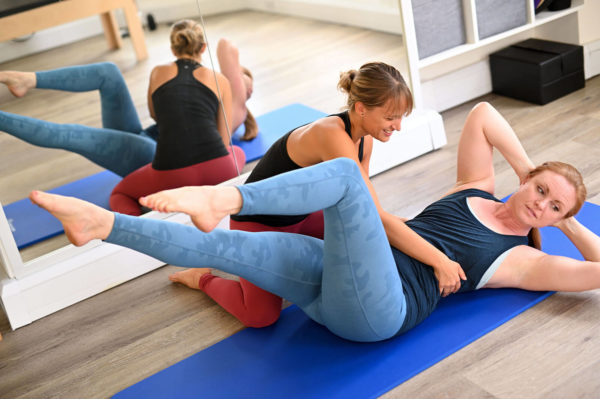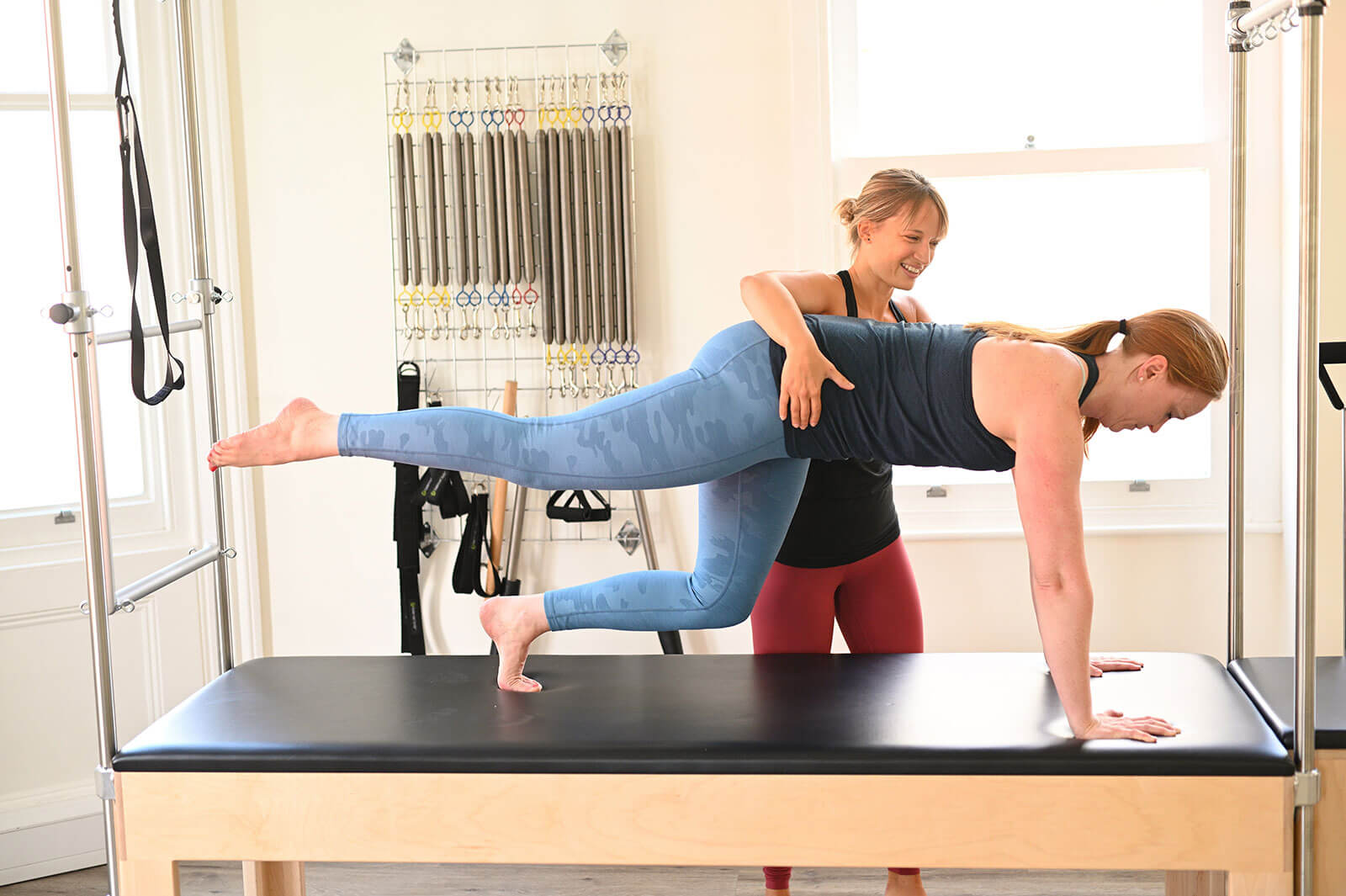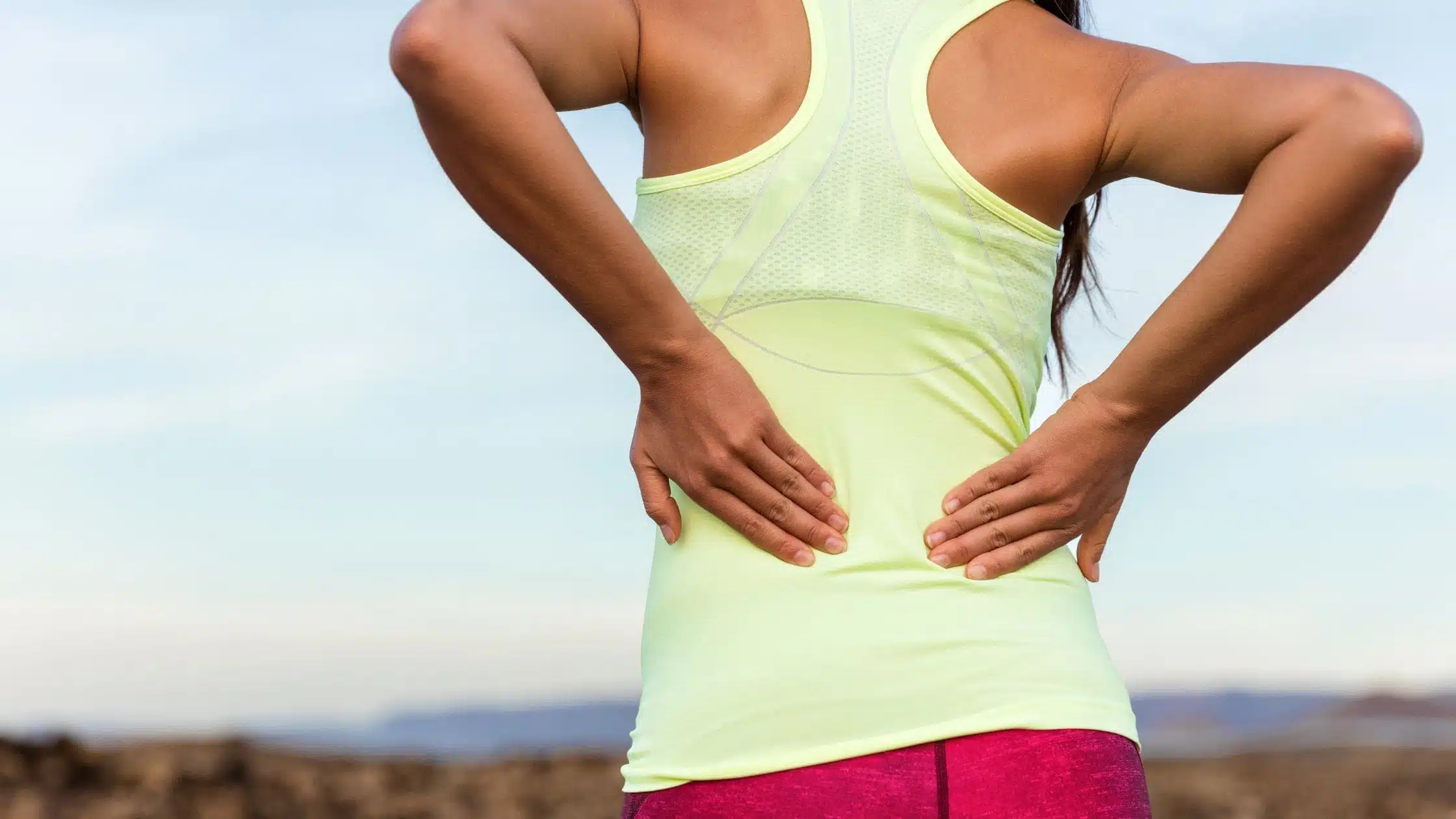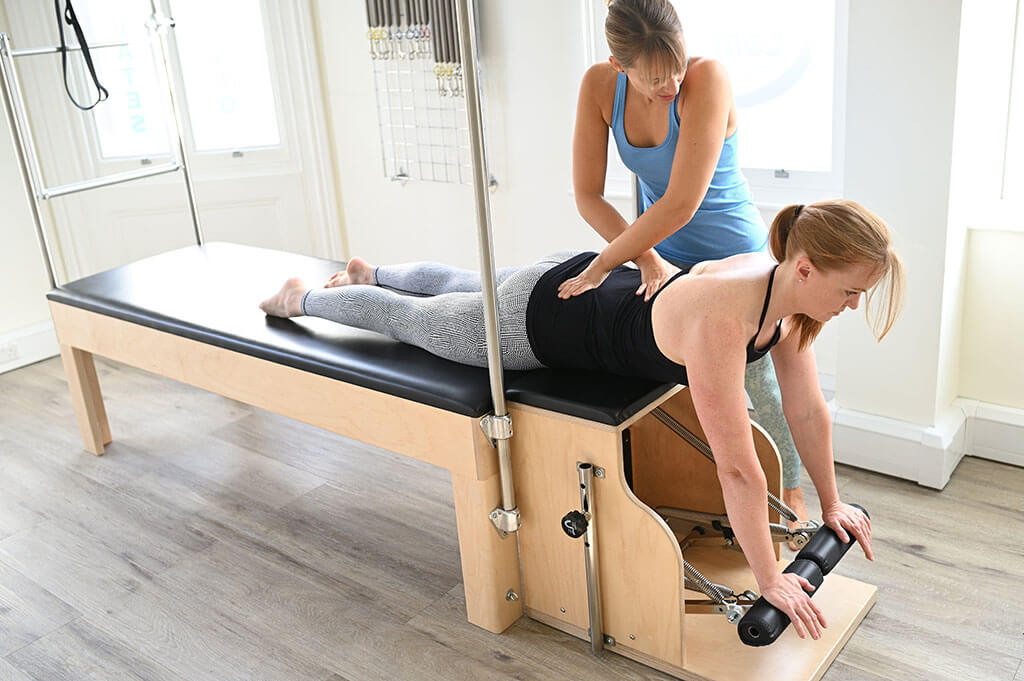Key Contributor: Charlotte Byrne, Chartered Physiotherapist
Lower back pain is a common health problem. It is so widespread, in fact, that 80 percent of Brits experience an episode of lower back pain at some point in their life.
Reassuringly, most of the time back pain isn’t caused by a serious medical condition. It normally gets better over time and without intervention. However, more complicated cases may require treatment such as manual therapy, exercise, or medication.
Regardless of its severity, back pain can affect your ability to work, exercise, and do other everyday activities. Because of this it can take a considerable psychological toll on its sufferers.
This is why it is important to learn some ways to manage – or avoid if possible – episodes of back pain. So read on and find out all about lower back pain: causes, treatments and management. We also answer the question – is Pilates good for lower back pain?’ and suggest lower back Pilates exercises to do and to avoid!
Key Takeaways
- Lower back pain is a common problem that affects most people in their lifetime. The cause of lower back pain is varied and conditions or injuries can affect many different structures. Exercise is a recommended form of management for lower back pain and should be used alongside other treatment methods that can be guided by your GP or Physiotherapist.
- Pilates is an effective tool for reducing lower back pain and stiffness and restoring function. It helps to improve joint mobility of the spine and surrounding joints as well as improving the strength and stability of supportive muscles.
- Pilates is safe to do if you’re experiencing symptoms related to facet joints and sciatica and you are under the guidance of a Physiotherapist or clinical Pilates instructor. If you’re unsure if exercise is appropriate for you, you should consult your GP or Physiotherapist first.
Lower back pain explained
Identifying the cause of back pain can be difficult, and sometimes frustrating as there is not always a clear anatomical cause. Getting a diagnosis is a good start to recovery but some back pain is described as “non-specific”. This means there is no obvious reason for back pain.
Another category of back pain is “mechanical”. This is where problems with the joints, bones, or soft tissue around the spine can cause pain. Your physiotherapist or doctor will explain to you which tissues they think may be affected and use that to guide your treatment.
The pain itself can range from mild discomfort, to acute or chronic if it continues on for longer than the 6-8 weeks we would usually expect.
With certain symptoms or chronic back pain, your doctor may recommend a scan to check for any underlying issues that may need further intervention. Your doctor may also prescribe a targeted exercise programme, acupuncture, or physiotherapy.
Is Pilates good for lower back pain? – The benefits of Pilates for lower back pain

1. Helps redistribute the forces in your spine
A stiff thoracic spine (mid-upper back) is something many people suffer with. It can cause, or exacerbate, lower back pain because a lack of mobility in the upper back generally means that lower spinal segments have to move more to compensate.
Luckily, many Pilates exercises improve mobility of the spine and are very effective at targeting the thoracic area. These exercises are designed to free up the segments of the upper spine so that they can do their job. This in turn takes some of the pressure off the lower back.
With dedication to your Pilates, these mobilising exercises, together with back strengthening work, will help improve your posture. Good posture will take pressure off your lower back. It should also help you avoid episodes of back pain in the future.
2. Targets the muscles that protect the spine
While there are many causes of back pain, studies show that weakening of the muscles of the trunk can be a primary cause. Luckily, Pilates exercises are known for effectively strengthening the trunk muscles.
Pilates exercises, like bridging, also help wake up the local stabilisers muscles which are the muscles that work to support the spine. For those with back pain this can be particularly helpful as dysfunction in these muscles can cause pain and instability in the spine.
3. Teaches your spine to function optimally
An episode of lower back pain can lead to you over-recruiting the glutes and hip muscles, which can then create more tension and pain.
This is where Pilates exercises like footwork on the reformer come in handy. These exercises teach muscle disassociation at your hips – a way of moving in the most efficient and natural way without muscle guarding.
What do our experts say?
 Equipment Pilates is especially advantageous for those with a fear of movement; the springs provide assisted movement, allowing patients to improve the quality of their movements and gain confidence. As they progress, these springs also offer resistance, helping to strengthen their muscles. Another great benefit of pilates is the focus on evenly distributed movement through the spine, this helps to spread the workload reducing the likelihood of strain and injury. Charlotte Byrne.
Equipment Pilates is especially advantageous for those with a fear of movement; the springs provide assisted movement, allowing patients to improve the quality of their movements and gain confidence. As they progress, these springs also offer resistance, helping to strengthen their muscles. Another great benefit of pilates is the focus on evenly distributed movement through the spine, this helps to spread the workload reducing the likelihood of strain and injury. Charlotte Byrne.
Pilates exercises for lower back pain
Pilates side to side
This is an excellent exercise to do to relieve pain and to introduce some gentle rotation to the spine. The feet are wider than hip width and the knees bent. Turn the hips and knees to one side and turn your head to look in the opposite direction. Repeat 8-10 each way.
The upper body should stay relaxed and heavy as the lower body moves. Try to move from your middle getting some activation through the oblique abdominals. a
Figure 4 mobility
This exercise helps to mobilise the hips and muscles around the hips and back including those in your gluteal area. This Pilates exercise for low back pain can be beneficial if you are feeling any tension coming into the back of your hips or legs.
Lift one foot onto the opposite knee and then supporting the thigh with your hands gently rock side to side to feel a stretch into the glutes and back. Repeat for around 30 seconds on both sides and do this 3-4 times.
Knee hug and roll
This is a lovely exercise to get gentle mobility in the spine in flexion. Use the arms to support you and then aim to let the spine relax as you rock side to side or move the legs in circles.
Repeat for 30 seconds x 3.
Pilates prone press
Prone press is an excellent exercise to get some extension through the spine in a safe and controlled way. This can often help the back pain immediately and in the longer term by increasing the thoracic mobility and reducing the load on the spine.
Lie on your front and think about the pubic bone pressing gently down towards the floor so that you keep the lumbar spine in neutral. As you inhale glide the shoulder blades back, send the elbows back and lift the chest reaching your breast bone forwards imagining you are lengthening the spine. Inhale and lower back down.
Repeat 8-10 times.
Modified side plank
We often hear about planks and side planks for core strength but they can be too advanced and too much of a challenge to do when you have back pain. This version is from the Polestar Pilates repertoire and is a prep exercise for Pilates side kick. It is excellent for starting to engage the oblique abdominals and glute med to bring strength around the sides of your trunk.
Have the knees forward of the hips and the elbow underneath the shoulder. Lift the hips pressing into the knees and elbow on the floor. Your hips will then come forward into more extension as your waist lifts. Imagine you are pulling the knees and elbow closer together to activate your underneath side.
Repeat 6-8 each side.
Pilates exercises to avoid with lower back pain
What exercises to avoid with lower back pain will depend on the cause of your symptoms as well as the severity and duration of the symptoms. In most cases, taking the approach of avoiding aggravating positions such as end of range flexion or extension is recommended as this may promote further aggravation of structures or muscle spasm. For many people, moving under heavy load or with quick intensity should also be avoided as this is likely to also exacerbate symptoms. Participating in Pilates under the guidance of a physiotherapist or clinical Pilates instructor will ensure that your program is tailored appropriately for you and that you are progressing at the right time and pace. If you’re unsure if exercise is safe for you at this time, we recommend you consult your GP or Physiotherapist before starting.
Common causes of lower back pain
Stress, repetitive movements or positions and lifting things awkwardly can all lead to back pain. Some common medical conditions can also contribute to pain. These conditions include:
- Vertebral disc prolapse (commonly referred to as a slipped disc) is where some material of the disc can cause irritation or pressure on a nerve. This can cause back pain and numbness, tingling and weakness.
- Ankylosing spondylitis (an inflammatory disease affecting the spine): this causes pain and stiffness that’s usually worse in the morning and improves with movement. Over time it can lead to fusion of some of the joints in the spine.
- Spondylolisthesis (a bone in the spine moving forwards out of position onto the bone below): this can cause lower back pain and stiffness, as well as numbness and tingling sensation.
- Facet joint syndrome: this involves pain at the joint between two vertebrae in your spine. This would usually cause pain on one side of the lower back.
- Muscle strains and tears: with muscular problems, lower back pain tends to be one-sided.
Other Treatments for lower back pain
While each person with back pain will need to be treated individually there is general advice which applies to all. Advice about managing back pain includes:
- Visit a doctor: your doctor will be able to advise you on whether you have symptoms that indicate a scan or another form of treatment is needed.
- Medication: using painkiller and anti-inflammatory medication to help you manage your pain can be a good idea – but it is important to check that the medicine is safe for you to take first. Ask advice from a pharmacist if you’re not sure.
- Stay active: it is important to continue with your daily activities as much as possible when suffering with an episode of lower back pain. Although it may feel difficult, keeping moving regularly has been shown to help people heal more quickly.
- See a manual therapist: hands on treatment or massage can help to ease muscle tension, reduce pain and aid healing.
- Meditate: studies show that meditation can help you tolerate pain better. It can also reduce stress and tension in the body, which in turn can help with pain reduction.
- Use heat: heat packs or hot water bottles can help ease the pain.
- Work on your posture: remember your best posture is your next posture so avoid sustained positions or repetitive movements.
Managing lower back pain
When it comes to managing back pain, The National Institute of Health and Care Excellence recommends a combination of approaches and emphasises the importance of exercise as well as manual treatment.
According to the NHS website, Pilates exercises can also help back pain sufferers. If you’re injured or suffering with lower back pain, however, it is important to see a rehab-trained Pilates instructor who can prescribe exercises that are safe and beneficial for your condition.
Frequently Asked Questions
Can I do pilates with lower back pain?
Yes, you can absolutely do Pilates with lower back pain. If you’re unsure if Pilates is appropriate for you, you can consult your GP or Physiotherapist before starting. Pilates is a very effective tool to help reduce acute symptoms of lower back pain as exercises can be easily modified to find positions and intensity levels appropriate for each individual. In many cases, progressive and gradual movement of the spine and body is helpful to relieve symptoms and get the body moving back to full function. For those with chronic lower back pain, a graded exercise routine is recommended to help restore function and reduce future episodes of acute pain.
Is Pilates good for facet joint pain?
Facet joint pain is a common form of lower back pain. It can cause local pain and stiffness and is likely to be worse when extending the spine (arching backwards). Pilates is a great exercise rehabilitation tool to help with facet joint pain. Pilates can help safely restore mobility of the spine and help strengthen structures around the spine to reduce the load going through the joints.
Is Pilates good for sciatica?
Exercise is a recommended management tool for Sciatica. In the early stages of rehab in particular, it is important that exercise is gentle and doesn’t irritate the nerve. Pilates is therefore safe and effective for sciatica as exercises can be modified to provide supported, gentle movement and then slowly progressed as symptoms allow. For a painful injury such as sciatica, it is important to exercise under the appropriate guidance, so we recommend reviewing with a physiotherapist first and ensuring your exercise is overseen by a physiotherapist or clinical Pilates instructor, rather than participating in a fitness or group class.
You can find us at one of our Pilates studios in London and speak to us about your lower back pain. You can find us at Complete Pilates in Angel or any of our studios (see our Chelsea Pilates studio or our Pilates studio in London City) for more information, please get in touch online or contact us on 0203 764 5668.
These blogs are designed to give information to everyone, however, it is important to remember that everyone is different! If you have not seen one of our therapists and have any questions about injuries, what you have read or whether this may be useful to you, please just ask. We are more than happy to help anyone and point you in the right direction. Our biggest belief is that education is key. The more you understand about your injury, illness and movement, the more you are likely to improve.






